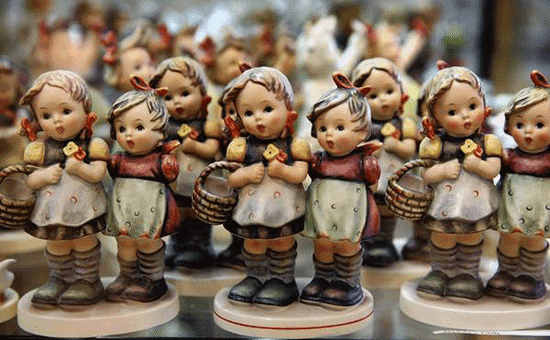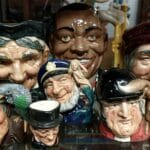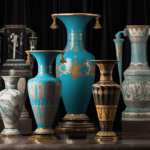Imagine a world where tiny ceramic figures captivate your heart and transport you back in time. Hummel figurines, those treasured collectibles adorning shelves and cabinets, hold a captivating history that’s just as charming as their adorable faces. Join us on a delightful exploration into the enchanting world of Hummel figurines, where we’ll uncover the secrets behind their enduring charm and timeless appeal.
History of Hummel Figurines
You know those adorable little figurines of children, often dressed in cute outfits, maybe carrying a basket of flowers or a playful puppy? Those are Hummel figurines, and they’ve been capturing hearts for nearly a century. Their story is a mix of art, history, and a touch of nostalgia, all rolled into one.
From Sketchbook to Shelf: The Birth of a Hummel
It all started in the 1930s in Germany. A talented artist and nun, Sister Maria Innocentia Hummel, had a knack for sketching charming images of children. Her drawings were full of life, innocence, and a certain sweetness that resonated with people.
Around the same time, a porcelain company called Franz Goebel was looking for fresh, appealing designs. When they saw Sister Hummel’s delightful drawings, they knew they had struck gold. A partnership was formed, and in 1935, the first Hummel figurines were brought to life in porcelain.
Inspiration From Everyday Life
Sister Hummel wasn’t just drawing from imagination; her artwork was deeply rooted in her own experiences. Growing up in a large family and later working as a schoolteacher, she was surrounded by the energy and spirit of children.
This is probably why her figurines capture such genuine emotion. They aren’t just static figures; they feel like snapshots of childhood joy, mischief, and wonder. It’s no surprise that they became especially popular in the post-World War II era, offering people a heartwarming reminder of simpler times.
Journey Across the Ocean
Speaking of the post-war period, that’s when Hummel figurines really took off in popularity, especially in the United States. American soldiers stationed in Germany would often purchase these charming figures as souvenirs to send back home to loved ones.
Imagine receiving a small package from overseas, and inside, nestled in protective layers, is this delicate porcelain figure of a child holding a tiny bouquet of flowers. It’s a tangible piece of comfort, a reminder of home, and a symbol of hope during a time when people were rebuilding their lives. This surge in popularity is thought to be linked to a broader interest in all things German during that period. Some experts suggest that Americans, amidst the backdrop of the Cold War, found solace in the idyllic scenes depicted in Hummel figurines, which offered a stark contrast to the prevailing anxieties of the time.
More Than Just Cute Figurines
While Hummel figurines are undeniably adorable, they represent something deeper, too. Sister Hummel’s strong faith and dedication to her order, the Franciscan Sisters of Siessen, played a significant role in her art.
The sale of her figurines actually helped support the order’s charitable works, including teaching and missionary efforts. So, each figurine purchased wasn’t just a sweet decoration; it was a small contribution to a greater good. This connection to faith and charity may have contributed to the figurines’ appeal, particularly among certain religious communities.
A Global Phenomenon
Over the decades, Hummel figurines have become a beloved collectible worldwide. People are drawn to their timeless appeal, the exquisite craftsmanship, and the sense of heartwarming nostalgia they evoke.
Even today, new generations are discovering the charm of Hummel figurines, ensuring that Sister Hummel’s legacy of art, faith, and the simple joys of childhood continue to be celebrated. However, the market for Hummel figurines has undoubtedly shifted in recent decades.
Why are Hummels no longer valuable?
So, we were talking about why those cute little Hummel figurines that grandma used to collect aren’t worth as much these days. It’s a bit of a head-scratcher, right? They’re charming, well-made, and remind us of simpler times. Well, it turns out there are a few key reasons why they’ve lost their shimmer in the collectibles market.
One of the biggest culprits is simply that there are too many Hummels out there. Think about it – for years, these figurines were mass-produced, and while that made them accessible, it also meant they weren’t exactly rare. When something is everywhere, it’s just not as special, and that definitely impacts its value.
Then there’s the issue of changing tastes. The folks who were initially drawn to Hummels – we’re talking about your grandparents’ generation – are, well, getting older. Sadly, as people age, they downsize, their collections get dispersed, and sometimes the younger generation just isn’t interested in keeping grandma’s prized figurines. And let’s be honest, millennials and Gen Z have their own ideas about what’s cool, and those ideas usually don’t involve rosy-cheeked children in lederhosen.
It’s a classic case of supply and demand. We have a huge supply of Hummels floating around, but the demand just isn’t there like it used to be. This is a common phenomenon in the world of collectibles. What’s hot today might be yesterday’s news tomorrow. Remember Beanie Babies? Yeah, those don’t exactly pay for college anymore.
But hey, that doesn’t mean your grandma’s Hummel collection is worthless! It still holds sentimental value, and who knows, maybe tastes will change again someday. The world of collectibles is full of surprises! For now, it seems those adorable little figurines are best appreciated for their craftsmanship and the memories they hold rather than their potential resale value. It is worth noting that the value of any collectible can fluctuate, and experts believe there is a chance that Hummels could experience a resurgence in popularity.
What is the rarest Hummel figurine?
We’ve been exploring the charming world of Hummel figurines, these little pieces of art that seem to capture a simpler, more innocent time. People all over the globe have been charmed by them, turning collecting them into a beloved hobby. But there’s one question that always seems to pop up: which one is the rarest of them all?
Well, imagine finding a tiny, porcelain treasure tucked away in an antique shop. That’s what tracking down the rarest Hummel figurine feels like. And the winner, the one that makes collectors’ hearts skip a beat, is none other than the “Bookworm.” This sweet little figurine depicts a young girl, completely absorbed in a book while perched on a bench. She’s the picture of quiet contentment, and that might be part of what makes this figurine so special.
You see, the “Bookworm” wasn’t around for very long. It was only produced for a short period back in the 1950s, which makes finding one today a real challenge. And because it’s so rare, its value has skyrocketed. Think somewhere in the ballpark of $275, making it a true prize for any serious Hummel collector. However, experts caution that even the estimated value of the “Bookworm” can fluctuate based on factors such as condition and where it’s being sold.
But here’s the thing about rarity – it’s not always an exact science. While the “Bookworm” is widely considered the rarest, there might be other incredibly scarce Hummel figurines out there, just waiting to be discovered. Maybe tucked away in an attic, or even misidentified in a dusty shop. It’s this element of surprise and the thrill of the hunt that keeps collectors coming back for more. It is also worth mentioning that some Hummel collectors specialize in specific themes or time periods, which might make certain figurines rarer within those niche collecting circles.
How can you tell if a Hummel is valuable?
Okay, so you’ve got your hands on a Hummel figurine, or maybe you’re thinking about starting a collection. These charming little porcelain figures have been captivating hearts for decades, and some of them can be surprisingly valuable! But how can you tell if yours is a hidden treasure or just a sweet little decoration? Let’s break it down:
Think Like an Antique Roadshow Appraiser
First things first, remember that value is relative. It’s not just about how much someone might pay for your Hummel, but also about the story it tells and the joy it brings. That being said, certain factors do tend to make a Hummel more attractive to collectors – and that usually translates to a higher price tag.
1. Age: Older Often Means More Valuable
Hummel figurines, especially those crafted before World War II, are like fine wine – they often become more desirable with age. This is partly because fewer of these older figurines survived the war, making them rarer and more sought after.
How to Check: Look for a trademark (TMK) marking on the bottom of the figurine. This mark can help you pinpoint the approximate year it was made. There are charts and resources online that can help you decipher these markings.
2. Size and Intricacy: Bigger and Bolder Can Be Better
Imagine a simple Hummel of a single child versus a larger, more elaborate scene with multiple figures and intricate details. Which do you think took more time and skill to create? You guessed it – the larger and more complex piece.
This principle often applies to Hummels. Figurines with more detail and larger size often fetch higher prices, especially if they’re in excellent condition. However, some collectors might prioritize charm and expressiveness over size and intricacy, so it’s important to consider the specific figurine and the target market.
3. Condition is Key: Think “Mint Condition”
Just like a vintage comic book or a classic car, a Hummel in pristine condition is going to be worth significantly more than one with chips, cracks, or fading.
What to Look For:
- No Cracks or Chips: Carefully examine the figurine for any signs of damage, especially around thin areas like hands and feet.
- Vibrant Colors: Over time, Hummel colors can fade, especially if they’ve been exposed to direct sunlight. Bright, clear colors are a sign of good condition.
- Original Finish: The glossy finish on a Hummel should be smooth and unblemished. Any scratches or dullness can impact its value.
While these factors are generally true, it’s important to remember that some collectors appreciate the patina and character that comes with age, and might even be looking for figurines with signs of wear and tear.
4. Rarity Rules: The Thrill of the Chase
Some Hummels were produced in limited quantities, making them highly sought after by collectors. These might include:
- Special Editions: Hummels created to commemorate a specific event or anniversary.
- Limited Runs: Figurines manufactured for a short period or in a restricted number.
- Rare Variations: Occasionally, slight variations occur in the production process, creating unique pieces that are highly collectible.
Where to Look for Clues: Look for any markings on the figurine or its accompanying box that might indicate a special edition or limited run. Online databases and Hummel collector guides can also be invaluable resources.
5. When in Doubt, Consult an Expert
If you’re serious about determining the value of your Hummel figurine, your best bet is to consult with an experienced appraiser or antique dealer who specializes in these collectibles. They can provide an informed evaluation based on their knowledge of current market trends and comparable sales.
Remember:
- The world of Hummel collecting is constantly evolving. New information and discoveries are made all the time, so it’s important to stay updated through reputable sources.
- While value is important, don’t forget the sentimental value and personal enjoyment that your Hummel brings. Whether it’s worth hundreds or simply holds a special place in your heart, it’s a piece of art history that you can cherish.
Are Hummels Worth Any Money?
So you’ve inherited your grandma’s collection of those adorable little Hummel figurines, or maybe you stumbled upon a dusty box of them at a flea market. You’re probably wondering, “Are these things actually worth anything?” Well, the answer isn’t as simple as a yes or no. It’s a bit like figuring out the value of an old comic book – it depends!
Let’s talk about what makes a Hummel valuable (or not).
Think of it like a checklist. The more boxes you can tick, the higher the chances your Hummel could be worth a pretty penny:
- Age: Just like with fine wine, older Hummels are often more sought after. Those made before World War II, especially, are considered vintage treasures and are pretty rare.
- Rarity: Ever heard the saying “they don’t make them like they used to?” It rings true with Hummels. Limited-edition or special-release figurines are like rare stamps – everyone wants them, but few are lucky enough to have them.
- Condition is Key: Imagine buying an antique book only to find pages missing. Not ideal, right? The same goes for Hummels. A figurine in mint condition, with no chips, cracks, or repairs, will always be worth more than one that’s seen better days.
- Popularity Contest: Some Hummel designs are just more popular than others. It’s like those iconic Beanie Babies everyone went crazy for – certain themes or characters just resonate with collectors more, driving up demand and price.
Beware of Fakes!
Unfortunately, the world of collectibles attracts its fair share of imitations. Here’s how to protect yourself from getting duped:
- Play Detective: Genuine Hummels have special markings, like a tiny “TMK” logo and a unique factory number. Think of these as their fingerprint – no two are exactly alike.
- Trust the Experts: When in doubt, it’s always best to buy from reputable dealers or auction houses. They’re like the Sherlock Holmes of Hummels and can spot a fake a mile away.
Figuring Out What You Have
Putting a price tag on a Hummel isn’t an exact science. If you’re serious about knowing its true worth, consider consulting a professional appraiser. They’re like art detectives who can unravel the mysteries of your figurine’s history and value.
But Remember…
Even if your Hummel collection doesn’t make you a millionaire overnight, don’t underestimate the value of sentimentality. These little figurines often hold precious memories and family history. Those stories, my friend, are priceless.
What should I do with Hummels?
Alright, so you’ve got these Hummel figurines, right? Maybe you inherited them, maybe they’ve been gathering dust in the attic for years, or maybe you just stumbled upon them at a flea market. Now you’re wondering, “What on earth do I do with these things?” Don’t worry, you’re not alone! Let’s explore some options:
First things first: It’s probably a good idea to get an idea of what you’ve actually got. Hummels can range in value from a few bucks to hundreds or even thousands of dollars, depending on things like their age, condition, and rarity. A quick online search or a chat with an antique appraiser can give you a ballpark figure.
Feeling the entrepreneurial spirit? If you’re looking to make a little cash, selling your Hummels might be the way to go. Online marketplaces like eBay and Etsy are popular choices, or you could try specialized antique websites like Ruby Lane. If you prefer a more personal touch, consider visiting local antique shops or consignment stores to see if they’re interested.
Not really your style, but you want them to find a good home? Donating your Hummels is a fantastic way to declutter while also supporting a worthy cause. Think about reaching out to local charities, thrift stores, or even museums – they might be thrilled to take these charming figurines off your hands.
Got a sentimental streak? Hey, there’s absolutely nothing wrong with holding onto things that have special meaning! If your Hummels evoke fond memories or were passed down through your family, keep them! Display them proudly on a shelf, in a glass cabinet, or even incorporate them into your home décor in a fun and quirky way.
A little TLC goes a long way: If your Hummels have seen better days (a chip here, a scratch there), don’t despair! Professional restoration services exist, and while they might cost a bit, they can often work wonders on bringing your figurines back to their former glory. You can also find DIY restoration tips and tricks online, but proceed with caution – you don’t want to accidentally devalue a precious piece.
Ultimately, the decision is yours! There’s no right or wrong answer when it comes to deciding what to do with your Hummels. Weigh your options, consider your personal attachment (or lack thereof!), and choose the path that feels right for you. Who knows, you might even discover a newfound appreciation for these whimsical little figurines along the way!
What are the most sought after figurines?
Picking up right where we left off, let’s dive deeper into the hunt for those super desirable figurines that collectors go crazy for. It’s more than just looks – a figurine’s backstory, the materials used, and even our own feelings play a big role in what makes them valuable.
Think of it like this: imagine a figurine that was only made for a short time, maybe even a hundred years ago. It’s like finding a rare baseball card – there just aren’t that many out there anymore. Plus, if it’s tied to a historical event or a famous person, that ups the ante even more.
Now, let’s talk craftsmanship. A figurine sculpted with incredible detail, maybe from rare materials like ivory or jade, will always catch the eye of a serious collector. It’s like the difference between a mass-produced poster and a hand-painted masterpiece – the level of skill and artistry just shines through.
And then there’s the emotional factor. Ever notice how some figurines just tug at your heartstrings? Maybe they remind you of your childhood or a favorite book. That nostalgic connection, that feeling of warmth and familiarity, is something you can’t put a price tag on. It’s what makes collecting so personal and rewarding. Some argue that this emotional connection is what drives the entire collectibles market, as people are drawn to objects that evoke positive memories or feelings.
What Makes a Figurine Valuable?
Okay, so we know what collectors look for in general, but let’s break it down even further. Here are some key things that can make a figurine worth a pretty penny:
- Age: Just like fine wine, older figurines tend to be more valuable. They’ve stood the test of time, both literally and figuratively. This is because older figurines are more likely to be rare, especially if they were produced in smaller quantities or if many examples were destroyed over time.
- Condition: Imagine finding a pristine comic book from the 1950s – that’s what it’s like to find a figurine in mint condition. No chips, cracks, or fading – just pure, collectible beauty.
- Rarity: Remember those limited-edition sneakers everyone lined up for? The same principle applies to figurines. The fewer there are, the more desirable they become. This is a basic principle of economics at play – scarcity drives up demand.
The Crème de la Crème of Figurines
Ready to drool over some seriously sought-after figurines? Here are a few names that make collectors weak in the knees:
- Hummel Figurines: These adorable porcelain figures, often featuring children in sweet poses, are a classic example of timeless charm.
- Royal Doulton Figurines: These elegant English porcelain figurines often depict historical figures or scenes, adding a touch of sophistication to any collection.
- Lalique Figurines: Created by the legendary French glassmaker René Lalique, these pieces are known for their breathtaking artistry and use of vibrant colors.
- Lladro Figurines: Hailing from Spain, these porcelain figurines are known for their incredible detail and lifelike qualities. Imagine a dancer frozen mid-pose, every fold in their dress captured perfectly – that’s the magic of Lladro.
- Royal Nymphenburg Figurines: These German porcelain figurines are the epitome of luxury and craftsmanship. Each one is a miniature masterpiece, meticulously crafted with an unparalleled attention to detail.
Keep Exploring!
The world of figurine collecting is vast and exciting, with new discoveries waiting around every corner. Researching different makers, styles, and time periods can be incredibly rewarding. Don’t be afraid to follow your curiosity and see where it leads you!
What happened to Hummel figurines?
Remember those adorable Hummel figurines that seemed to grace the shelves of every grandma’s house? You know, the ones with those sweet little faces and rosy cheeks, often caught in a moment of childhood innocence? Well, those figurines have a story to tell, and it’s not all sunshine and rainbows. While they were once wildly popular, especially in the US after World War II, their popularity took a nosedive in the early 2000s. Imagine a rollercoaster soaring high, then slowly losing steam before coming to a complete stop – that’s the trajectory of Hummel figurine sales.
So, what exactly happened? In a nutshell, people just stopped buying them as much. It’s like how bell bottoms were all the rage, and then suddenly, they weren’t. Tastes change, and sadly for Hummel, the market for those charming porcelain figures dwindled. This change in consumer preferences led to some tough times for the German company, Goebel, who made the figurines. They even had to declare bankruptcy in 2006. Ultimately, they decided to stop producing the figurines altogether in 2008.
But wait, there’s a silver lining! While new Hummels aren’t being made, the ones that are already out there are now considered collector’s items. Think about it – something that isn’t being produced anymore automatically becomes rarer, right? That’s part of what makes them appealing to collectors. Plus, there’s a certain nostalgic charm to these figurines. They remind people of a simpler time, maybe even their childhoods.
If you’re curious to learn more about Hummel figurines, there’s a whole museum dedicated to them in Germany called the Berta-Hummel Museum. It’s named after the woman who inspired the figurines with her heartwarming drawings.
Here’s a little summary of the Hummel figurine saga:
| Event | Year |
|---|---|
| Peak Popularity | 1950s-1970s |
| Decline in Sales Begins | Early 2000s |
| Goebel Bankruptcy | 2006 |
| End of Production | 2008 |
So, while you might not see Hummel figurines lining the shelves of department stores anymore, they haven’t completely disappeared. They’ve just transformed into cherished collectibles, treasured by those who appreciate their history and artistry. Who knows, maybe one day, they’ll even make a comeback! Some experts suggest that the renewed interest in vintage and antique items could potentially lead to a resurgence in the popularity of Hummels.
Are Hummel Figurines a Good Investment?
So, you’re curious about Hummel figurines, those adorable little porcelain figures of children? Maybe you inherited a collection, or perhaps you’re thinking about starting one yourself. Either way, you’re probably wondering if these charming characters could also be a smart investment.
The truth is, it’s a bit complicated. Some Hummel figurines have indeed increased in value over time, sometimes quite significantly. But others? Not so much. It’s a lot like trying to predict which baseball cards will become valuable – there are a lot of factors at play.
What Makes a Hummel Figurine Valuable?
Think of it like this: a figurine’s value is kind of like its own little storybook. The more interesting and unique the story, the more valuable it becomes. Here are some of the “chapters” that collectors pay close attention to:
- Age: Imagine finding a dusty old treasure chest in your attic. Older figurines, especially those made before World War II, are like finding treasures from a bygone era. They’re often rarer and more sought after.
- Condition: Just like a well-loved book, a figurine in pristine condition is more desirable. Any chips, cracks, or fading can significantly lower its value.
- Rarity: Ever noticed how some books become instant bestsellers, while others fade into obscurity? Limited edition or rare Hummel figurines are like those coveted first editions – everyone wants them, but only a lucky few will own them.
- Popularity: Some themes or characters just resonate with people more than others. It’s the same with Hummel figurines. Those depicting popular scenes or figures tend to be more in demand.
- Authenticity: Imagine discovering your “treasure chest” find is actually a clever fake. It’s crucial to ensure a figurine is the real deal. Look for genuine trademarks and be wary of reproductions.
Making Sense of the Market
Navigating the world of Hummel figurines can feel a bit like learning a new language. But don’t worry, there are ways to become more fluent:
- Talk to the Experts: Reputable antique dealers and Hummel specialists can provide valuable insights into market trends and help you determine the potential value of your figurines.
- Attend Auctions: Auctions are a great way to observe what collectors are currently paying for specific figurines. They can give you a sense of current market demand and potential future value.
- Connect with Other Collectors: Join online forums or local clubs dedicated to Hummel figurines. Sharing knowledge and experiences with fellow enthusiasts can provide valuable insights.
More Than Just an Investment
Beyond the potential for financial gain, Hummel figurines hold a special place in many people’s hearts. They evoke memories of childhood, family, and simpler times. Whether you’re an experienced collector or just starting out, remember that the true value of a Hummel figurine lies not only in its potential monetary worth but also in the joy and nostalgia it brings.
The Bottom Line?
So, are Hummel figurines a good investment? It’s not a simple yes or no answer. It depends on a variety of factors. While some figurines can appreciate in value, others may not. Treat it like any investment: do your research, understand the market, and be prepared for the possibility that values can fluctuate. Ultimately, the most rewarding part of collecting Hummel figurines is the joy and connection they bring to collectors and admirers alike.
What is the Difference Between Goebel and Hummel?
So, we’ve established that Goebel and Hummel are intertwined in the world of porcelain figurines, but they aren’t quite the same thing. Think of it this way: Goebel is like the master chef, whipping up all sorts of beautiful porcelain creations. Hummel figurines? They’re one specific recipe in Goebel’s cookbook, beloved for their charming, rosy-cheeked children.
Let’s break it down a bit further:
- Goebel: Imagine a bustling workshop, filled with skilled artisans pouring their hearts into crafting exquisite porcelain pieces. That’s Goebel! Since 1871, they’ve been producing a diverse range of high-quality porcelain goods — think delicate teacups, intricate plates, whimsical animal figurines, and even elegant vases.
- Hummel Figurines: Now, picture those adorable, nostalgic figurines often depicting children in heartwarming scenes. Those are likely Hummel figurines! Designed by Sister Maria Innocentia Hummel, a Franciscan nun with a talent for capturing innocence and joy, these figurines are exclusively brought to life by Goebel.
To put it simply: All Hummel figurines are crafted by Goebel, but not all Goebel creations are Hummel figurines.
Here’s a handy way to remember the difference:
| Feature | Goebel | Hummel Figurines |
|---|---|---|
| Product Range | Diverse (dinnerware, figurines, etc.) | Exclusively figurines |
| Design | Varied | Based on Sister M.I. Hummel’s artwork |
| Manufacturer | Goebel | Goebel (exclusive producer of Hummel designs) |
The Takeaway: While the names “Goebel” and “Hummel” are often mentioned together, it’s important to remember that Hummel figurines represent just one facet of Goebel’s broader artistic legacy!
Are Hummel figurines collectable?
You bet they are! Those adorable Hummel figurines, with their rosy-cheeked children and charming scenes, have been capturing hearts (and wallets) for decades. But are they valuable? That’s what we’re here to find out.
How much are Hummel figurines worth?
Well, like most collectibles, it really depends. Think of it like this: a well-loved copy of a popular book might have sentimental value, but it’s probably not going to fetch a fortune. A rare first edition, on the other hand, could be a different story.
The same goes for Hummels. Some factors that can influence their worth include:
- Age: Vintage Hummels, especially those in good condition, are usually more valuable than newer ones.
- Rarity: Ever notice how some Hummels seem to be everywhere, while others are like finding a four-leaf clover? Scarcity definitely plays a role in value. Models like “Merry Wanderer” or those featuring multiple figures are often highly sought after.
- Condition: A chipped paintbrush or a missing flower can make a big difference. Hummels in pristine condition, especially with their original boxes, are generally worth more.
- Design: Some Hummel designs are simply more popular than others. Intricate details and larger sizes can also add to their value.
How can you tell if a Hummel figurine is real?
Authenticity is key! Genuine Hummels have specific markings and characteristics, like the “M.I. Hummel” stamp and the trademark “Goebel” mark, often found on the bottom. They also have that distinctive German craftsmanship and attention to detail. If you’re unsure, it’s always a good idea to consult with a reputable antiques dealer or appraiser.
Are Hummel figurines a good investment?
That’s a tricky one. While some rare Hummels have been known to increase in value, the market can fluctuate. It’s not a guaranteed get-rich-quick scheme. However, if you’re passionate about Hummels and appreciate their artistry, collecting them can be a rewarding hobby. Some collectors believe that as these figurines become rarer, their value may increase, but there’s no guarantee.
What’s the bottom line?
Hummel figurines are definitely collectible, and some can be quite valuable! Their worth depends on a variety of factors, and it’s always wise to do your research. Remember, the most important thing is to collect what you love. Whether you’re drawn to their history, their craftsmanship, or simply their adorable faces, Hummel figurines offer a unique blend of art and nostalgia that continues to charm collectors and enthusiasts alike.
For further exploration into the fascinating history of art and culture, you might enjoy reading about the History of Hotel Parq Central Albuquerque, the History of Hurricanes in Cancun, the History of Hurricanes in St Augustine Florida, or the History of Jarabe Tapatio.
- Crypto Quotes’ Red Flags: Avoid Costly Mistakes - June 30, 2025
- Unlock Inspirational Crypto Quotes: Future Predictions - June 30, 2025
- Famous Bitcoin Quotes: A Deep Dive into Crypto’s History - June 30, 2025
















